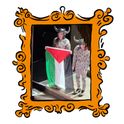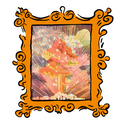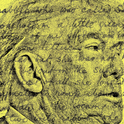It was with joy that I saw that Geoff Dyer has made a selection of DH Lawrence’s essays. I first encountered Dyer through his 1997 genre-busting work that described his failure to write a biography of Lawrence, Out of Sheer Rage. Then (full disclosure) in 2013 I made a Culture Show Special with him for the centenary of Lawrence and his wife Frieda’s honeymoon crossing of the Alps, when I experienced first-hand his wittily-heterodox take on the writer who united us in our pilgrimage.
It is high time that Lawrence’s non-fiction had another airing. Since the Leavisite-moralist Lawrence of the 1950s was replaced by the pro-porn Priest of Love of the 1960s, who was in turn displaced by the misogynist-proto-fascist Lawrence of the 1980s, the best of Lawrence has been lost to view. All that’s left in the popular consciousness is a novel (Lady Chatterley’s Lover) that inspires lingerie ranges, and a film in which Oliver Reed and Alan Bates wrestle naked (Women in Love). Life with a Capital L is a much-needed corrective. For anyone who hasn’t read any Lawrence, I would readily recommend it as a good place to start. It presents Lawrence as diverse, brilliant, and strange. He was all these things.
In his introduction Dyer argues that Lawrence is at his strongest in his short forms, which often trouble the boundaries between fiction, autobiography and criticism—rather than those “strenuous” novels, on which Lawrence himself placed such metaphysical burdens. In Lawrence at his best, writes Dyer, “Sensations flicker and blaze into ideas that are presented as though they are data from some instrument calibrated to a pitch of receptivity so extreme as to be abnormal or even pathological”—a phenomenon often displayed in the volume.
The range of the essays is vast: a meditation on Alpine crucifixes; how spring asserts itself even whilst one mourns for the winter; how Indians dance in New Mexico; why he doesn’t like living in London; why, if men are to give women the pattern by which to live, it should at least be a decent one; and why Dostoevsky’s Grand Inquisitor was in the right after all.
The selection is less obviously Dyer-esque (he coins the term "Lawrence-ese") than one might expect. It includes lengthy extracts from the highly-metaphysical Study of Thomas Hardy, and the piece on Dostoevsky is as intellectually-dense and politically-questionable as anything Lawrence ever wrote. Dyer states that he avoids essays which appear in easily-available volumes, such as Twilight in Italy, Mornings in Mexico and Studies in Classic American Literature. Yet are these really better-known, or easier to find, than Study of Thomas Hardy?
In striking contrast to the scholarly Cambridge University Press Complete Works (significantly not used as the source-text), the volume contains scarcely any footnotes, and only a few endnotes giving the publication date and place of each essay. The lack of footnotes extends to not translating the German quotations in the review of Thomas Mann’s Death in Venice, though it notably fails to extend to Dyer’s own introduction, to which he somewhat cheekily appends nearly 30 footnotes.
Dyer repeatedly asserts Lawrence’s contemporaneity: his “writing floats free from the period of its composition, from the anxiously shared prerogatives of the age, in a way that rarely happens with the modernists who were his contemporaries.”
This is particularly true of Lawrence’s religious perceptions, and for this reason it is a shame that only one essay ostensibly on religion (“The Risen Lord,” 1929) is included. In essays such as “On Being Religious,” Lawrence sets out an attitude which will resonate with many who can believe neither in a materialist universe, nor in the dogma of any given religion. “When a man says There is a God, or There is no God, or I don’t know whether there’s a God or not, he is merely using a little word like a toy pistol, to announce that he has taken an attitude.” Regarding Christ: “There have been other saviours, in other lands, at other times, with other messages. And all of them Sons of God.” Yet “For the moment, we are lost. Let us admit it. None of us knows the way to God. The Lord of time and space has passed over our horizon, and here we sit in our mundane creation, rather flabbergasted.” The best we can do is “listen to the dark hound of Heaven, and start off into the dark of the unknown, in search.” Lawrence’s writings, throughout his career, describe that search—and encourage us to make our own.
Despite Dyer’s distancing of himself from Lawrence at his most earnest, his selection and its title indeed honour “Life with a Capital L.” Lawrence lived in a way that makes the rest of us feel, by comparison, permanently half-asleep. The intensity of his engagement with “Life” produced ideas of varying degrees of attractiveness to the present; but the intensity—what his wife Frieda called his “Bejahung” [saying yes]—is its own inspiration. As Lawrence writes at the end of his Apocalypse: “For man, the vast marvel is to be alive… Whatever the unborn and the dead may know, they cannot know the beauty, the marvel of being alive in the flesh. The dead may look after the afterwards. But the magnificent here and now of life in the flesh is ours, and ours alone and ours only for a time.”
Catherine Brown is Head of English, New College of the Humanities
Life with a Capital L: essays chosen and introduced by Geoff Dyer is published by Penguin Classics












